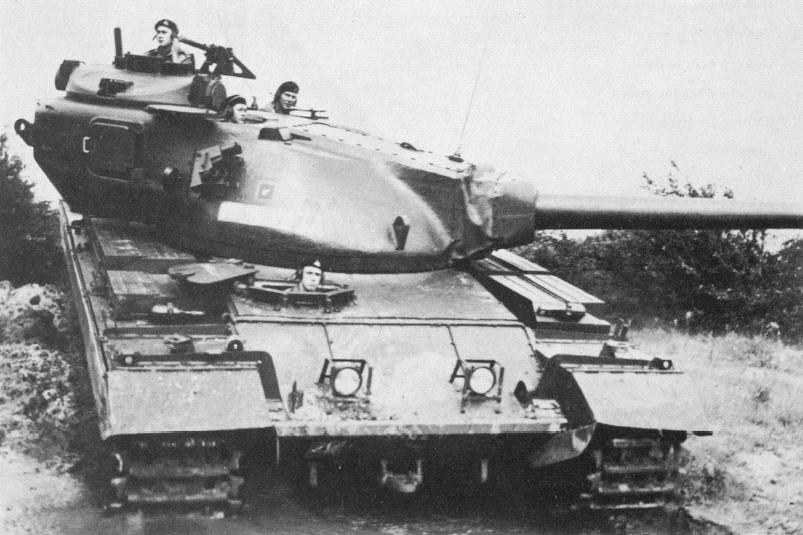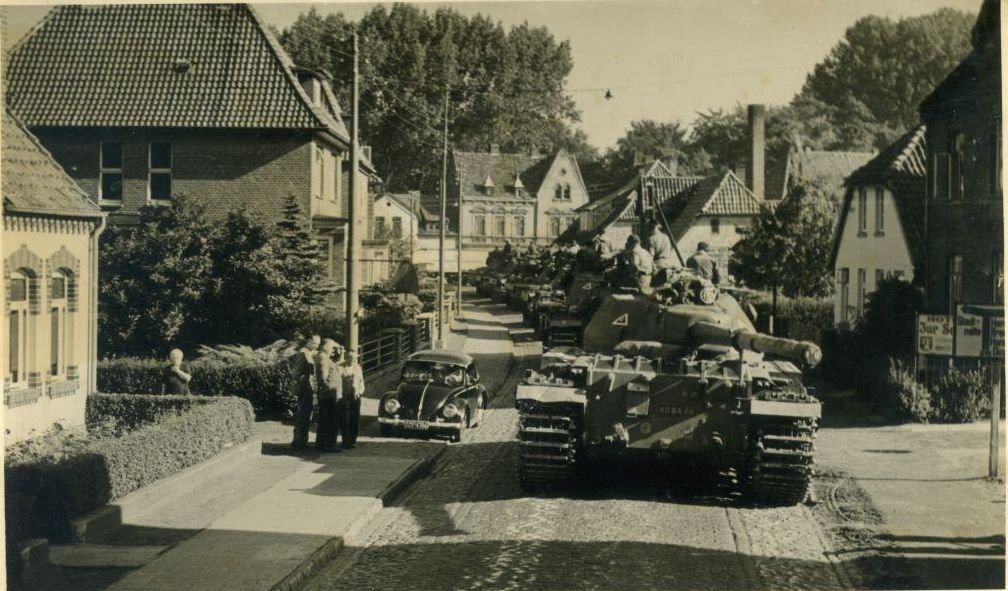As you know World of Tanks is transferring to HD at the moment, and with that the tank's armour gets reviewed and brought as close as possible to its historical level. Well at the moment the FV214 Conqueror is undergoing its HD treatment, and so we were tasked with looking for armour values. Some of you might already be reaching for Google, muttering about having already seen an armour profile for the Conqueror, well yes and no. There are plenty of guesses about the Conquerors armour level, but nothing exact. Equally there's some evidence to suggest that the turret casting isn't a uniform thickness, with the armour basis (The LOS thickness) being constant, but the actual thickness being varied depending on the slope.
 |
| A naked Conqueror turret |
That's where I came in, Although I do have a local Conqueror, I've not got a thickness gauge or any experience of using it, so the likelihood of me being successful is nil, but what I could do was start combing archives for a primary source answer. I did find some interesting stuff but no armour value. Again the mystery deepens. There isn't a given value. Even on documents that list all the other armour thickness, the frontal turret thickness isn't given, just the level of protection it is required to give.
But first, lets talk about the Conqueror's early life. In the late 40's the British opinion was that armour had the upper hand in the armour vs gun battle, and looking at Soviet tanks of the time they were concerned about tank armament. The British were facing a dilemma. On one hand they needed a weapon with a high enough rate of fire to "suppress" enemy positions during an attack, this of course was entirely suited to guns such as the 20 pounder or the US 90mm. But both those guns were deemed inadequate against the latest Soviet armour. The answer was obvious, looking back at the Second World War they could see a system that had worked, the Sherman Firefly and 75mm armed Sherman's that had made up a large chunk of the British armoured force.
So the plan was formed to give Centurion regiments a 120mm armed Centurion. Initial trials resulted in the FV4004 Conway, and it was foreseen that over time the tank could be developed into something with a lower turret.
As an aside, its curious to note that despite the perceived issues in 1948 the British were looking at developing a new infantry tank with utterly ridiculous armour (400mm-350mm) and only a 77mm gun.
Now I need to quickly explain the way the British armour organisation was seen in this period. Armoured regiments were seen as mobile striking units, used for the attack. RAC regiments were viewed as defensive in nature.
The Conqueror was to be grouped into RAC regiments, with Cromwell's as command tanks, and armoured regiments would be equipped with Centurions with 20 pounders and FV4004 Conway's. However the Conqueror production and development went a lot faster than had been foreseen, and therefore the plan changed to one squadron in each RAC regiment and one troop in each armoured squadron would be converted into Conquerors. This resulted in a total requirement of 250 tanks needed.
Right from the start the Conqueror came under fire. First was the army in 1949 complaining about the protection levels and the poor ballistic shape of the Conqueror's turret. One proposal was to remove the gunner to improve the shape of the turret but this was thrown out for two reasons, first of all two man turrets were a bad idea. Secondly it would remove one of the Conqueror's big advantages, it was one of, if not the first tank to have hunter/killer ability. If you don't know what that is I'll explain. While the tank's gunner is engaging an enemy tank, the commander is free to look about and select a follow on target, as soon as the gunner has finished with his target he can instantly and effortlessly switch to the target the commander has highlighted. This allows for a much faster and rapid engagement of targets.
 |
| Note the direction the Commanders cupola is facing. |
But back to the armour values. The first big surprise was a 14mm Burster plate attached to the hull. This stand off armour was for the role of detonating HEAT and HESH warheads away from the hull. Some of you might ask why you've never heard of this before? Simply because it wasn't fitted in peacetime but was held as a theatre reserve to be deployed in the time of war. The other obvious question is how would that effect gun depression over the front hull? One suggestion was to shave 10mm of armour off the front slope to improve the depression, but that was never implemented. On the Conqueror although the gun could depress to -7.5 degrees, beyond -5.5 degrees a limiter kicked in that prevented the gun from being laid or used. This was in place because the Conqueror had a nasty habit of sticking its gun barrel into the ground. This was caused by the huge length of the L1 120mm barrel, which swung about a lot preventing it from firing on the move. See this video for an example, notice how much the gun barrel bounces around:
(video should start at 20 seconds in, if not that's where you want to be)
But what of the turret armour, the thing that set me off on the trip. Well the requirement was to be immune from the Soviet 100mm gun at point blank range through an arc of 60 degrees (30 degrees either side of the gun barrel). However after testing the best that could be achieved with the turret was that level of protection through half the required arc. This does allow us the ability to make a guess on the required thickness, as the documents helpfully included a table of Soviet gun performance.
But the issue remained that the turret wasn't very well armoured. That's when I hit gold. There was a proposal for a new better shaped turret, with drawing!
The gunner has been moved to the enlarged cupola, so the gunner and the commander are side by side. You'll note that the cupola is actually very well protected with a steeply sloped chunk of armour. The armour thicknesses are also given. Frontal protection is 13.5" with the sides offering 7" of protection.
And to close off, here's some follow on data on the Conqueror, that's just to help you to form a picture of the technical abilities of a Conqueror.
Turret traverse speeds were measured and found to be between 22-24 seconds for 360 degrees. Maximum elevation of the gun was 15 degrees. Reloading the gun took seven seconds and the road speed was 21.3 mph.






I like your watermark!
ReplyDeleteI figured it needed one...
DeleteDo you know If the new turret design will make it into the game? or is being considered at least?
ReplyDeleteNo clue.
DeleteI only find stuff and pass it up the chain. We're strongly campaigning for it though, the feeling I get is: Don't hold your breath.
First it has to get OK'd by Management, then it has to be placed in the queue for the modellers.
Thanks for the honest awser. Nice work and good find Listy ;)
DeleteYou want somebody to do a better watermark?
ReplyDeleteI knocked this up in 30secs:
http://postimg.org/image/dddhuxkf7/
Interesting that the measuring equipment didn't work. Shape or something to do with the metal/steel the turrets made out of?
I think its due to the surface finish, that's causing the issues. Of course I've only heard it second hand.
DeleteThere are a few of other methods being investigated to get measurements (One suggestion which was only put forward, somewhat jokingly, was to get to a range hulk with a tape measure and measure the thickness of the holes...)
Isn't it possible to physically measure the Conq turret? Seems to be a lot of gunless ones about, I would have though a large set of curved calipers, with one arm though the gun hole, could be used to confirm/disprove other measurement methods.
DeleteEither that or take a moulding (sp?) of the turret.
There's one at the Isle of Wight museum, no gun but rusted to hell. It has the advantage of not being shot to bits though.
http://www.massimocorner.com/afv/Surviving_Conqeror.pdf
Does the document show the armor layout for the turret? or just list "13.5 inches frontal"
ReplyDeleteAn example for another tank, the Chief had DTIC scan a document that lists the M6A2E1 as having 9 inches of turret armor on the front, but as it does not show a location for said 9 inches so they won't implement it in game.
I think its armour basis, so the exact thickness would change depending on where you look at it from.
DeleteHmmm... I thought it was (meant to be) a IS-series killer.
ReplyDeleteBut I guess I must do something wrong, as I have more difficulties to pen. them than they me. Hell, most tanks just aim just above the gun and shoot. Most of the time they do damage, sometimes and I mean sometimes they bounce.! So always hull down, nah, most of them aim at the top of my turret anyhow.
So IMHO the top of the turret and also the cheeks are a bit, how to say it nice, to easy to pen.
With a better armored turret Top and the spaced armor plating at the front (for the heat and hesh shells) this tank will be fun to play again. It will at least stay alive a bit longer.
It is this research that has made WG reverse their decision on putting the Chieftain into WoTs.
ReplyDeleteA tragedy.
I couldn't agree more.......I am obliged to acknowledge the good work here but.......I wish you never done it in the first place! Now my Chieftain dreams are gone thanks to you!
DeleteWait, you list that naked turret as being a conqueror turret, but where's the gunner sight or crew hatches? Is this actually a prototype of the two man turret?
ReplyDeleteAlso, yeah, I wish you held off on this a few months.
Is that final image not actually an earlier Conqueror turret? Rob Griffin's book on the Conqueror describes a turret exactly like that being part of the 1950 spec for the Conqueror - which was rejected by the RAC as having both the Gunner and the Commander in the FCT made the Gunner essentially redundant.
ReplyDelete